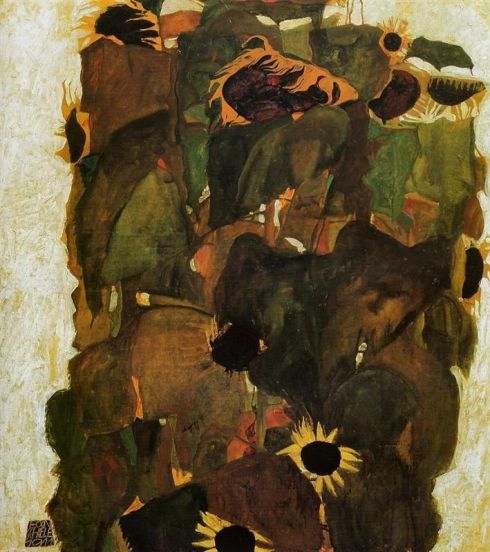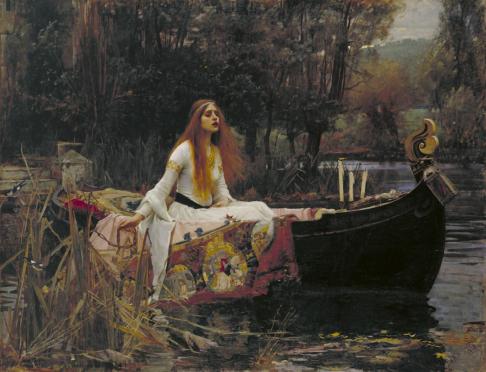Egon Schiele was just one of many painters who gave identity to sunflowers; he painted them laden with a heavy burden of melancholy and alienation. Gazing at Schiele’s sunflowers, for me, raises an awareness of the haunting fragility of life. I hope you’re intrigued by the oxymoron in the title.
 Egon Schiele, Sunflowers, 1911
Egon Schiele, Sunflowers, 1911
Artist most widely associated with the sunflower motif is Vincent van Gogh, who painted the flowers using quick, ecstatic brushstrokes, in thick coat of intense, almost fire-like, burning yellow-orange colour, their petals almost dissolving on canvas, and saw them as symbols of blinding sun which, in the end, causes madness, or even death. While his vision of sunflowers may have something to do with his over indulgence in absinthe and the fervent sun of Arles, Egon Schiele’s sunflowers are pure sceneries of the soul.
Schiele’s sunflower scenes are gentle portraits of human alienation. He was twenty-one years old when he painted this painting, titled simply ‘Sunflowers’ (1911), but he already showed a profound interest and understanding of the world and society around him. At the age of fifteen Schiele lost his father to syphilis, and he quickly took off the rose-tinted glasses of childhood and became an adult, or at least he tried. My point is that his work is very mature and thoughtful. His self-portraits from the same year show his pondering on the question of identity, and his place in the society. In the same way, these sunflowers here represent the state of his soul, not the scenery he saw before him.
 Egon Schiele, Sunflowers, 1911
Egon Schiele, Sunflowers, 1911
In 1913, Schiele wrote to an art collector Franz Hauer: ‘I also do studies, but I find, and know, that copying from nature is meaningless to me, because I paint better pictures from memory, as a vision of the landscape – now, I mainly observe the physical movements of mountains, water, tress and flowers. Everywhere one is reminded of similar movements made by human bodies, similar stirrings of pleasure and pain in plants. Painting is not enough for me; I am aware that one can use colours to establish qualities. – When one sees a tree autumnal in summer, it is an intense experience that involves one’s whole heart and being; and I should like to paint that melancholy.‘*
The melancholy that Schiele so eloquently described in the letter (he was a poet as well), is exactly the feeling which overwhelms me when I look at this painting. In stingy colours, using light brushstrokes Schiele created a true psychological study. His sunflowers appear tired and weary at first sight, and believe me, the second sight only intensifies the first one. Murky yellows, muddy browns, shades of green – neither of which is fresh or relaxing, all indicate a certain fatigue of the soul, decay of traditional values. Notice the sparse petals: some are missing while others are wildly protruding. Their stems are weak, dry, directionless, about to break – ‘heads’ of sunflowers resemble a tired head of a disappointed, forlorn man carried on fragile shoulders. The scene inevitably reminds me of these verses ‘Broken thoughts run through your empty mind‘ and ‘Endless hours in bed, no peace, in this mind/ No one knows the hell where innocence dies‘, again by Manic Street Preachers (Sleepflower). I may be aggravating with these verses, but I think similar themes often occur in many artworks, regardless of the time-period and style, don’t you?
A poem that would go well with Schiele’s vision of sunflowers:
Georg Trakl: The Sunflowers
‘You golden sunflowers,
Feelingly bowed to die,
You humble sisters
In such silence
Ends Helian’s year
Of mountainous cool.
And the kisses
Make pale his drunken brow
Amidst those golden
Flowers of melancholy
The spirit is ruled
By silent darkness.‘
 Gustav Klimt, The Sunflower, 1906, Oil on Canvas. 110 x 110 cm
Gustav Klimt, The Sunflower, 1906, Oil on Canvas. 110 x 110 cm
Unlike Schiele’s isolated sunflowers, imbued with sadness, Klimt’s sunflowers have a mystical aura about them. He painted these sunny flowers incorporated in garden scenes. Whereas Schiele isolated his sunflowers, exposed their anguished heads and tired stems, Klimt’s fear of ‘horror vacui’, ‘fear of empty space’, drove his to fill the entire surface of his garden scenes with flowers, whether in form of tiny red dots and green dashes, or in a form of true flowers such as sunflowers. Klimt painted them with their heads looking in different directions, their green leafs dancing in the wind like tulle skirts. Jewish Hungarian journalist and author, Lajos Hevesi (1843-1910), noticed the contrast between bright yellow petals and ‘dark and mysterious’ inner space. Their appearance resembles the solar eclipse. Sunflowers did have a cosmic meaning to Klimt after all.





funny.. I looked at these the other day,, I love them,,
LikeLike
Yeah, funny… Schiele’s sunflowers have been on my mind the whole week… love them too 🙂
LikeLike